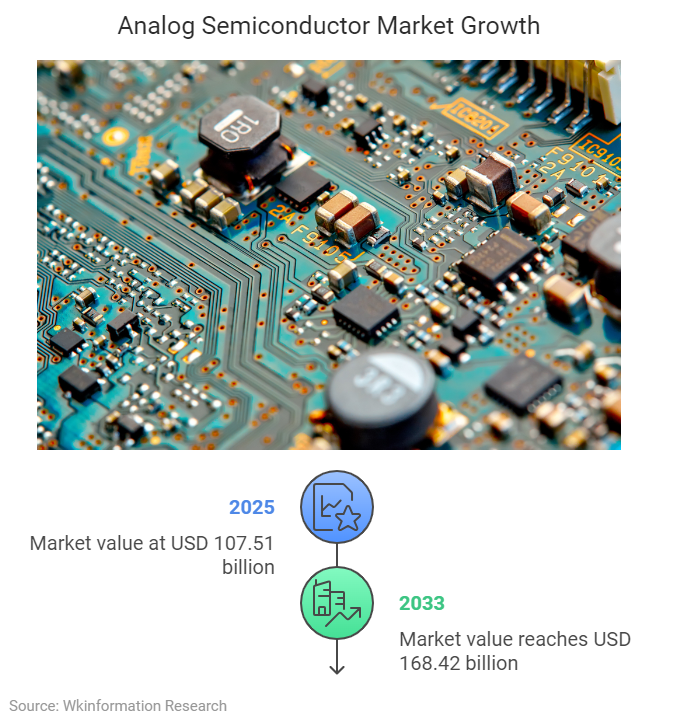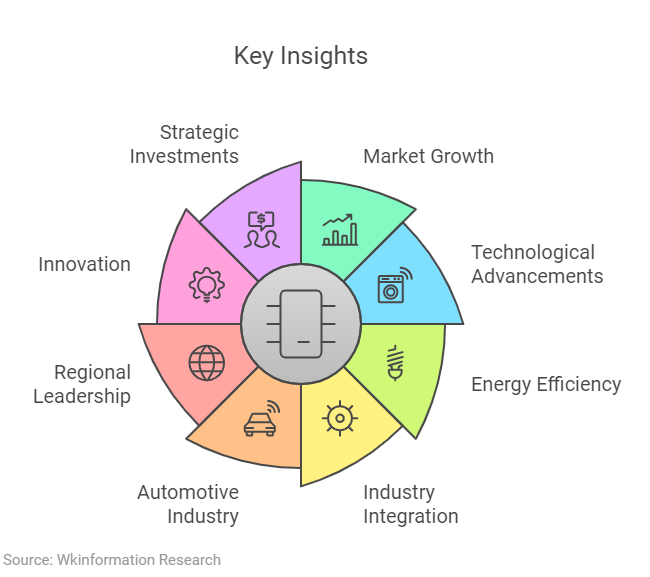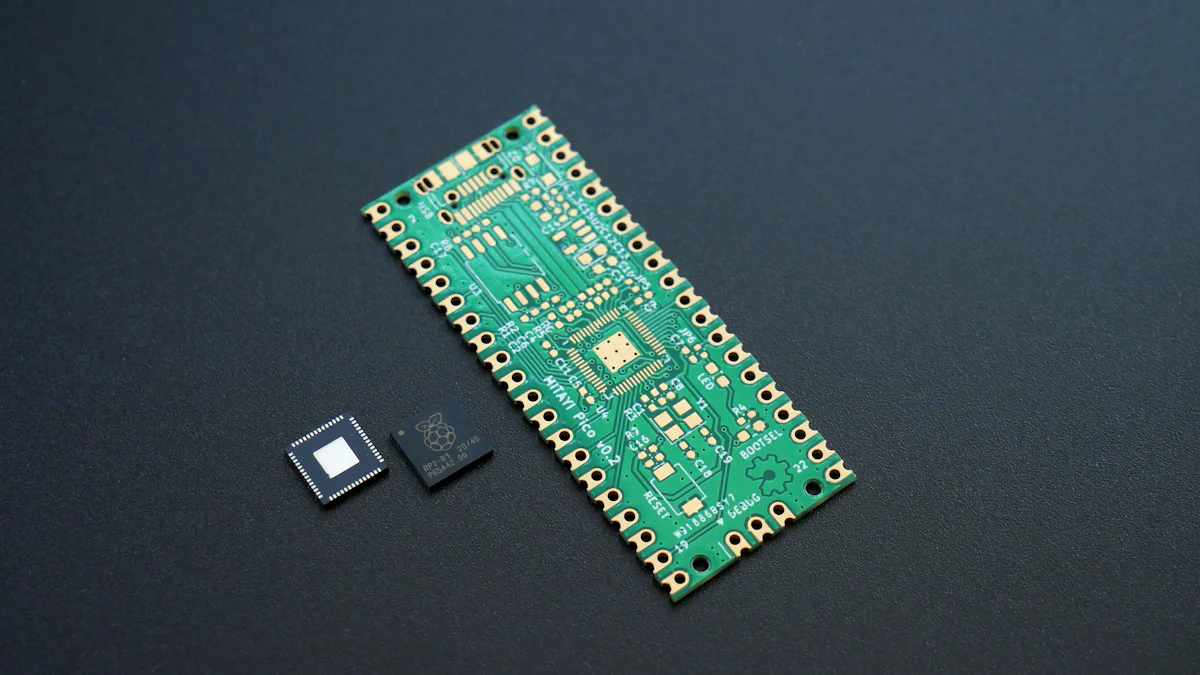
The global analog semiconductor market is witnessing remarkable growth, fueled by advancements in technologies like IoT, AI, and 5G. These innovations have amplified the demand for high-performance analog solutions, which play a pivotal role in powering modern devices. Industries such as automotive, telecommunications, and consumer electronics rely heavily on analog semiconductors to enhance efficiency and functionality. The market’s expansion is further driven by the increasing need for energy-efficient systems and the seamless integration of analog and digital technologies, positioning this industry as a cornerstone of technological progress.
Key Insights
- The global analog semiconductor market is projected to grow from approximately USD 107.51 billion in 2025 to USD 168.42 billion by 2033, driven by advancements in IoT, AI, and 5G technologies.
- Energy efficiency and sustainability are key priorities, with analog semiconductors playing a crucial role in developing eco-friendly technologies, particularly in electric vehicles and smart home devices.
- The integration of analog and digital technologies is a defining trend, enabling compact designs and enhanced performance in applications across telecommunications, automotive, and industrial sectors.
- The automotive industry is a significant growth driver, with increasing demand for analog components essential for battery management and advanced driver-assistance systems (ADAS).
- Asia-Pacific is the leading region in the analog semiconductor market, highlighting the importance of this region in global semiconductor production.
- Emerging companies and startups are fostering innovation in the analog semiconductor market, challenging established players and expanding the range of available solutions.
- Strategic investments in research and development are vital for companies to stay competitive and meet the evolving demands of various industries.

Overview of Market Trends and Growth Forecast
The global analog semiconductor market is undergoing rapid expansion, driven by technological advancements and increasing demand across various industries. Analysts project significant growth in the coming years, with the market poised to capitalize on emerging opportunities in sectors such as automotive, telecommunications, and consumer electronics. Understanding the current market size and the factors fueling this growth provides valuable insights into the industry’s trajectory.
Key Drivers of Market Growth
Several factors contribute to the sustained growth of the global analog semiconductor market. The increasing adoption of IoT devices, artificial intelligence, and 5G technology has significantly boosted the demand for analog solutions. These technologies rely on analog semiconductors to ensure seamless connectivity, efficient power management, and enhanced performance.
The automotive sector plays a pivotal role in driving market expansion. The shift toward electric vehicles (EVs) and autonomous driving systems has created a surge in demand for analog components. These components are essential for battery management, sensor integration, and advanced driver-assistance systems (ADAS). Additionally, the rising popularity of smart home devices and wearable technology has further fueled the need for innovative analog solutions.
Energy efficiency and sustainability have emerged as key priorities for industries worldwide. Analog semiconductors enable the development of energy-efficient systems, aligning with global efforts to reduce carbon emissions. This focus on sustainability has positioned the analog semiconductor market as a vital player in achieving environmental goals.
The global semiconductor analog market also benefits from substantial investments in research and development. Companies are prioritizing innovation to meet the evolving demands of consumers and industries. This commitment to technological advancement ensures that the market remains competitive and continues to grow.
Emerging Trends in the Analog Semiconductor Market

Integration with Digital Technologies
The integration of analog and digital technologies has become a defining trend in the semiconductor industry. This convergence allows for the development of compact and efficient designs, where both analog and digital functionalities coexist on a single chip. Mixed-signal integrated circuits (ICs) exemplify this trend, offering enhanced performance while reducing the space required for electronic components. These ICs are increasingly utilized in applications such as telecommunications, automotive systems, and industrial automation.
The rising demand for high-performance electronic devices has further accelerated this integration. Analog semiconductors play a critical role in managing signal aspects like phase, amplitude, and frequency, ensuring seamless communication between digital systems. As digital devices evolve, the need for effective power conversion and regulation systems grows, positioning analog semiconductors as essential components in modern electronics.
This trend also aligns with the growing adoption of IoT devices and the expansion of the automotive industry. Analog semiconductors enable reliable and efficient operation in these sectors, meeting the demands of consumers and industries alike. The integration of analog and digital technologies not only enhances functionality but also supports the development of innovative solutions for emerging applications.
Focus on Energy Efficiency and Sustainability
Energy efficiency and sustainability have emerged as key priorities across industries, driving the demand for advanced analog solutions. The rising need for power-efficient analog chips has become a focal point, as these components enable the creation of systems that consume less energy while maintaining high performance. This focus aligns with global efforts to reduce carbon emissions and promote environmental responsibility.
Analog semiconductors play a pivotal role in achieving these goals. They facilitate efficient power management in applications such as electric vehicles (EVs), renewable energy systems, and smart home devices. For instance, in EVs, analog components ensure optimal battery performance and energy utilization, contributing to the broader adoption of sustainable transportation.
The emphasis on sustainability has also spurred innovation in the analog semiconductor market. Companies are investing in research and development to create energy-efficient solutions that cater to the evolving needs of various industries. This commitment to innovation not only addresses environmental concerns but also strengthens the market’s position as a driver of technological progress.
As industries continue to prioritize energy efficiency and sustainability, the demand for analog semiconductors is expected to grow. These components will remain integral to the development of eco-friendly technologies, reinforcing their importance in shaping a sustainable future.
Market Segmentation Analysis
Market segmentation provides a detailed understanding of the global semiconductor analog market, enabling stakeholders to identify growth opportunities and tailor strategies effectively. This section explores the segmentation by type, application, and region, highlighting the diverse factors driving the semiconductor analog market.
By Type
The semiconductor analog chip market can be categorized into two primary types: general-purpose and application-specific analog semiconductors. General-purpose analog semiconductors serve a wide range of industries, offering versatility and adaptability. These components are essential for basic functions like signal amplification, power management, and data conversion.
Application-specific analog semiconductors, on the other hand, cater to niche markets with specialized requirements. Industries such as automotive and telecommunications heavily rely on these components for advanced functionalities. For instance, in the automotive sector, application-specific analog semiconductors support systems like battery management and advanced driver-assistance systems (ADAS). This segmentation underscores the importance of tailored solutions in meeting industry-specific demands.
By Application
The global semiconductor analog chip market spans multiple applications, reflecting its critical role across industries. Key sectors include:
- Industrial: Industrial applications dominate the analog semiconductor landscape. These components power automation systems, robotics, and energy management solutions.
- Automotive: The automotive sector represents a significant growth driver. The shift toward electric vehicles (EVs) and autonomous driving technologies has amplified the demand for analog semiconductors. These components ensure efficient power management, sensor integration, and safety system functionality.
- Communication: The communication enable seamless connectivity in 5G networks, IoT devices, and other communication technologies.
- Consumer Electronics: Consumer electronics rely on analog semiconductors for devices like smartphones, wearables, and smart home systems. These components enhance performance and energy efficiency, meeting the growing demand for advanced consumer technologies.
By Region
Regional analysis reveals significant variations in the growth and adoption of analog semiconductors. The Asia-Pacific region leads the global semiconductor analog market, driven by rapid industrialization, technological advancements, and a robust manufacturing base.
North America and Europe also play pivotal roles in the semiconductor analog market. North America benefits from strong investments in research and development, particularly in the automotive and telecommunications sectors. Europe emphasizes sustainability and energy efficiency, fostering innovation in renewable energy systems and electric vehicles.
Emerging markets in Latin America, the Middle East, and Africa present untapped potential. These regions are witnessing increased adoption of IoT devices and smart technologies, creating new opportunities for the analog semiconductor industry.
Key Drivers and Challenges
Technological Advancements Driving Innovation
The analog semiconductor industry thrives on continuous technological advancements. Innovations in areas such as power management, signal processing, and sensor interfacing have enabled analog semiconductors to support increasingly complex applications. These components play a pivotal role in creating signal characteristics like phase, amplitude, and frequency, which are essential for various electronic functions. The demand for high-performance devices has driven manufacturers to enhance the efficiency and functionality of analog chips.
Recent developments in semiconductor manufacturing have further accelerated progress. The adoption of smaller process nodes and advanced materials, such as Silicon Carbide (SiC) and Gallium Nitride (GaN), has led to the creation of more efficient and high-performance analog devices. These materials offer superior thermal conductivity and energy efficiency, making them ideal for applications in electric vehicles, renewable energy systems, and industrial automation.
The necessity for power management in almost all electronic products remains a key driver of the analog semiconductor market’s growth. Analog components ensure optimal energy utilization in devices ranging from smartphones to electric vehicles. This focus on energy efficiency aligns with global trends toward sustainability, reinforcing the importance of innovation in this sector. As technology evolves, the performance and efficiency of analog chips continue to improve, solidifying their role as indispensable components in modern electronics.
Challenges Facing the Analog Semiconductor Market
Despite its growth, the analog semiconductor market faces several challenges. One significant obstacle is the increasing complexity of designing and manufacturing analog components. Unlike digital semiconductors, which rely on binary logic, analog devices must handle continuous signals. This complexity requires specialized expertise and advanced manufacturing processes, which can increase production costs and time.
The semiconductor analog chip market also grapples with supply chain disruptions. Global events, such as geopolitical tensions and natural disasters, have highlighted vulnerabilities in the supply chain. These disruptions can lead to delays in production and delivery, impacting the industry’s ability to meet growing demand. Additionally, the reliance on rare materials like SiC and GaN poses challenges in sourcing and cost management.
Another challenge lies in the competitive landscape. Established players dominate the market, making it difficult for emerging companies to gain a foothold. The high cost of research and development further exacerbates this issue, as smaller firms may struggle to invest in innovation. Moreover, the rapid pace of technological advancements necessitates constant adaptation, which can strain resources and hinder long-term planning.
Regulatory compliance adds another layer of complexity. Governments worldwide have implemented stringent regulations to ensure the safety and sustainability of electronic components. While these measures promote environmental responsibility, they can also increase production costs and limit market entry for new players. Navigating these challenges requires strategic planning and collaboration across the industry.
Competitive Landscape

Major Players in the Analog Semiconductor Market
The analog semiconductor market features several dominant players who drive innovation and maintain a strong foothold in the industry. These companies leverage their expertise and resources to meet the growing demand for advanced technologies across various sectors.
- Intel Corporation: Intel stands out as a leader in the global semiconductor analog chip market, offering a diverse portfolio of products. Known for its powerful microprocessors, Intel also excels in providing solutions for IoT applications, data centers, and personal computing. The company’s focus on cutting-edge technologies such as artificial intelligence and autonomous driving ensures its continued relevance in the evolving market landscape.
- Qualcomm Technologies, Inc.: Qualcomm has established itself as a pioneer in wireless technology and connectivity solutions. Renowned for its Snapdragon processors and leadership in 5G technology, Qualcomm plays a critical role in advancing mobile devices and IoT solutions. Its global presence and commitment to innovation make it a key player in the semiconductor industry.
- Samsung Electronics Co., Ltd.: Samsung is a major contributor to the analog semiconductor market, particularly in the consumer electronics and IoT sectors. The company’s advanced semiconductor technologies power a wide range of applications, from mobile devices to industrial systems. Samsung’s dedication to research and development ensures its competitive edge in the market.
- Texas Instruments: Texas Instruments remains a prominent name in the analog semiconductor industry, particularly in North America. The company focuses on creating innovative products tailored to automotive, telecommunications, and industrial applications. Its consistent efforts to address evolving market needs have solidified its position as a market leader.
These major players continue to shape the industry through strategic investments, technological advancements, and a commitment to meeting the demands of diverse applications.
Emerging Companies and Startups
While established companies dominate the analog semiconductor market, emerging firms and startups are making significant strides. These new entrants bring fresh perspectives and innovative solutions, challenging traditional approaches and fostering competition.
- ON Semiconductor: This company has gained recognition for its focus on energy-efficient solutions and sustainability. By addressing the growing demand for eco-friendly technologies, ON Semiconductor has carved out a niche in the market.
- Analog Devices, Inc.: Analog Devices combines expertise in analog and digital technologies to create mixed-signal solutions. Its innovative approach has positioned the company as a key player in sectors like automotive and industrial automation.
- Startups in the IoT Space: Numerous startups are leveraging the increasing adoption of IoT devices to develop specialized analog solutions. These companies focus on creating compact, efficient, and cost-effective components that cater to specific industry needs.
Emerging companies and startups play a vital role in driving innovation within the global semiconductor analog chip market. Their contributions not only enhance competition but also expand the range of available solutions, benefiting industries worldwide.
Strategic Growth Opportunities
Automotive Industry
The automotive industry represents a significant growth avenue for the analog semiconductor market. The increasing adoption of electric vehicles (EVs) and advanced driver-assistance systems (ADAS) has amplified the demand for analog components. These semiconductors play a pivotal role in enhancing vehicle performance, safety, and energy efficiency.
Analog semiconductors support critical functions in automotive applications, including battery management, power control, and sensor integration. For instance, in EVs, these components ensure optimal battery performance by regulating energy usage and maintaining system stability. ADAS relies on analog semiconductors for precise sensor data processing, enabling features like collision avoidance and lane-keeping assistance.
The integration of more electronics into vehicles has further fueled the demand for analog solutions. Automakers increasingly rely on these components to develop innovative systems that improve user experience and operational efficiency. Wide-bandgap materials, such as Silicon Carbide (SiC) and Gallium Nitride (GaN), have also driven advancements in analog semiconductors, offering superior thermal conductivity and energy efficiency. These materials are particularly beneficial for high-power applications in EVs and renewable energy systems.
“Analog semiconductors enhance performance in automotive applications by enabling efficient power management and sensor integration,” as observed in industry trends. This underscores their indispensable role in shaping the future of transportation.
The automotive sector’s focus on sustainability and energy efficiency aligns with the capabilities of analog semiconductors. As the industry continues to innovate, the demand for these components will grow, creating substantial opportunities for market expansion.
Internet of Things (IoT)
The Internet of Things (IoT) has emerged as a transformative force across industries, driving the need for advanced analog semiconductors. These components enable seamless connectivity, efficient power management, and reliable signal processing in IoT devices, making them essential for the development of smart technologies.
Analog semiconductors facilitate the integration of sensors, actuators, and communication modules in IoT systems. They ensure accurate data conversion and transmission, which are critical for real-time monitoring and decision-making. For example, in smart homes, analog components power devices like thermostats, lighting systems, and security cameras, enhancing functionality and user convenience.
The rising adoption of IoT in industrial automation, healthcare, and agriculture has further expanded the scope of analog semiconductors. In industrial settings, these components support predictive maintenance and energy optimization, improving operational efficiency. In healthcare, analog semiconductors enable wearable devices to monitor vital signs and transmit data to healthcare providers. In agriculture, they power precision farming tools that optimize resource usage and increase crop yields.
The focus on energy efficiency and sustainability has also influenced the design of analog semiconductors for IoT applications. Manufacturers prioritize creating low-power solutions that extend battery life and reduce energy consumption. This aligns with global efforts to minimize environmental impact while meeting the growing demand for connected devices.
The IoT revolution highlights the critical role of analog semiconductors in enabling smart technologies. Their ability to manage power and process signals efficiently positions them as key enablers of innovation in this domain.
As IoT adoption continues to rise, the demand for analog semiconductors will grow exponentially. Companies that invest in developing tailored solutions for IoT applications will gain a competitive edge in this dynamic market.
Overview
The global analog semiconductor market is set to experience robust growth, driven by advancements in technology and rising demand across industries. Asia-Pacific emerges as a pivotal region, contributing significantly to the market’s expansion due to its strong industrial base, increasing consumer electronics sales, and rapid urbanization. The region’s dominance is further supported by its leadership in semiconductor production and innovation in IoT applications. Strategic investments and continuous innovation will remain essential for industry players to harness emerging opportunities and address evolving trends. This dynamic landscape underscores the critical role of analog semiconductors in shaping the future of technology.
| Report Attributes | Details |
|---|---|
| Base Year | 2024 |
| Market Size 2025 | 107.51 Billion USD |
| Market Size 2033 | 168.42 Billion USD |
| CAGR | 5.77% |
| Historical Year | 2019 – 2024 |
| Forecast Year | 2025 – 2033 |
| Report Coverage | Revenue Forecast, Market Competitive Landscape, Growth Factors, and Trends |
| Segments Covered | Type, Applications, and Region |
| Geographies Covered | North America, Europe, Asia Pacific, and the Rest of the World |
FAQ
What is an analog semiconductor and why is it important?
An analog semiconductor is an electronic component that processes continuous signals, generating characteristics such as phase, amplitude, and frequency. These semiconductors are essential for enabling advanced digital devices, ensuring seamless signal conversion and power management. Their importance lies in their ability to support cutting-edge technologies like artificial intelligence (AI), autonomous driving, 5G, and the Internet of Things (IoT). These components form the backbone of modern electronics, driving innovation across industries.
How do analog semiconductors contribute to the automotive industry?
Analog semiconductors play a pivotal role in the automotive sector by supporting critical functions such as battery management, power control, sensor integration, and data conversion. As electric vehicles (EVs) and autonomous driving technologies gain traction, the demand for these components continues to rise. They ensure efficient energy utilization, enhance safety systems, and enable advanced driver-assistance systems (ADAS). Their contribution extends to connected vehicle technologies, making them indispensable in shaping the future of transportation.
Why is energy efficiency a priority in the analog semiconductor market?
Energy efficiency has become a key focus due to global efforts to reduce carbon emissions and promote sustainability. Analog semiconductors enable the development of power-efficient systems, ensuring optimal energy usage without compromising performance. These components are vital in applications like electric vehicles, renewable energy systems, and smart home devices. Their role in achieving energy efficiency aligns with environmental goals, reinforcing their importance in modern technology.
How does the integration of analog and digital technologies benefit industries?
The integration of analog and digital technologies allows for the creation of compact, efficient designs where both functionalities coexist on a single chip. This convergence enhances performance and reduces the space required for electronic components. Mixed-signal integrated circuits (ICs), a result of this integration, are widely used in telecommunications, automotive systems, and industrial automation. This trend supports the development of innovative solutions, meeting the evolving demands of industries.
What challenges does the analog semiconductor market face?
The analog semiconductor market faces challenges such as the complexity of designing and manufacturing components, supply chain disruptions, and regulatory compliance. Unlike digital semiconductors, analog devices handle continuous signals, requiring specialized expertise and advanced processes. Supply chain vulnerabilities, including material shortages, can delay production. Additionally, stringent regulations increase production costs, posing hurdles for new entrants. Overcoming these challenges requires strategic planning and collaboration.
Which regions dominate the analog semiconductor market?
The Asia-Pacific region leads the analog semiconductor market, driven by rapid industrialization, technological advancements, and a strong manufacturing base. North America and Europe also hold significant shares, with North America benefiting from robust R&D investments and Europe focusing on sustainability. Emerging markets in Latin America, the Middle East, and Africa present untapped growth opportunities.
How do analog semiconductors support IoT applications?
Analog semiconductors enable seamless connectivity, efficient power management, and reliable signal processing in IoT devices. They facilitate the integration of sensors, actuators, and communication modules, ensuring accurate data conversion and transmission. These components power smart home devices, wearable technology, and industrial IoT systems. Their role in enhancing functionality and energy efficiency makes them critical for the growth of IoT applications.
What role do analog semiconductors play in consumer electronics?
Analog semiconductors are integral to consumer electronics, powering devices like smartphones, wearables, and smart home systems. They enhance performance, manage power efficiently, and ensure seamless signal conversion. These components meet the growing demand for advanced features and energy-efficient solutions in consumer technology, driving innovation in this sector.
How does innovation drive the analog semiconductor market?
Innovation remains a cornerstone of the analog semiconductor market. Companies invest heavily in research and development to create advanced solutions that address evolving industry needs. Recent advancements include the use of wide-bandgap materials like Silicon Carbide (SiC) and Gallium Nitride (GaN), which improve energy efficiency and thermal conductivity. Continuous innovation ensures the market remains competitive and capable of supporting emerging technologies.
Global Analog Semiconductor Market Report – Table of Contents
1 Market Study Overview
2 Basic Product Information
3 Market Analysis
4 Analog Semiconductor Related Market Analysis
5 Global Trend Summary
6 Competition by Manufacturer
7 Analysis of Key Players
8 Global Analog Semiconductor Revenue, Sales Categorized by Regions
9 North America Analog Semiconductor Market Size Categorized by Countries
10 Europe Analog Semiconductor Market Size Categorized by Countries
11 Asia-pacific Analog Semiconductor Market Size Categorized by Countries
12 South America Analog Semiconductor Market Size Categorized by Countries
13 Middle East and Africa Analog Semiconductor Market Size Categorized by Countries
14 Global Analog Semiconductor Industry Segment Analysis
15 Global Analog Semiconductor Market Forecast
16 Research Findings and Conclusion
17 Appendix


